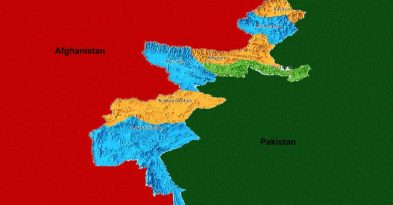In South Waziristan, a district of Khyber Pakhtunkhwa that borders Afghanistan, suspected militants recently targeted a girls’ school in the village of Karikot, near Wana City. This marks the second such attack this month. The overnight explosion damaged a newly constructed schoolroom, but fortunately, no casualties were reported.
The Afghan Taliban’s takeover in August 2021 exerted a significant psychological and ideological influence across the Durand Line, particularly in the merged districts of the former Federally Administered Tribal Areas (FATA) of Pakistan. This pivotal event emboldened the Pakistani Taliban, who are now re-emerging as a security concerns within Pakistan by increasingly targeting security forces, local communities, and further restricting girls’ education, thus reflecting a resurgence of militant activities in the region.
The female literacy rate in the former FATA region is distressingly low at 7.8%. According to the former FATA Annual Education Census 2017, only 37% of girls attend primary school and a mere 5% continue to secondary school. This compares to 49% of boys at the primary level and 17% at the secondary level. Additionally, it was reported that 14.7% of girls aged 3 to 13 had never been enrolled in any school.
Despite pre-existing challenges to girls’ education from local Taliban influences, the Taliban’s ascendancy in Afghanistan reinvigorated conservative factions. This led to heightened enforcement of stringent gender norms and an amplified discourse on the visibility and role of women in public spheres. This resurgence has negatively impacted societal attitudes, further complicating efforts for gender inclusivity and educational reforms in the region. Pashtun culture, particularly in the tribal areas, is already very conservative, and the Taliban’s policies have exacerbated the situation, severely limiting educational opportunities for girls and reinforcing conservative views on gender roles.
The ban on girls’ education over 12 years old in Afghanistan is a reflection of a reassertion of conservative values, influenced both by a strict interpretation of Islamic law and deep-rooted Pashtun tribal norms concerning gender roles. These norms prioritize the control of women’s visibility and actions in public spheres, often justified under the premise of protecting familial and societal honor. In December 2022, restrictions on women in Afghanistan intensified. Women were barred from attending university, and new regulations were introduced that limited their travel without a male relative, dictated their attire, restricted their employment opportunities, and even prohibited visits to local parks.
For over a decade, girls’ schools have been prime targets for militant groups affiliated with the Tehreek-i-Taliban Pakistan (TTP) with a shared agenda. These attacks have not only exacerbated the already poor infrastructure, but also instilled fear among the scarce teaching staff, severely hindering their ability to conduct classes and thereby limiting educational opportunities for local girls. Data on the extent of destruction is fragmented and not consolidated, but it is well-documented that the majority of these attacks have occurred in North and South Waziristan districts, known strongholds of Taliban activities where the targeting of educational institutions, especially those for girls, has been most intense.
Despite the proximity of girls’ schools to village dwellings and their protection by local Maliks (tribal chiefs), militants have persistently been able to target these buildings. This ongoing vulnerability raises questions about the effectiveness of local security measures. Additionally, about half of these schools have fallen into disuse—some abandoned, others repurposed by Maliks for personal uses such as guest houses or residences for second wives. This information comes from a report compiled over a decade ago by a national NGO to which I contributed. The failure to protect and maintain these schools underscores the complex challenges of sustaining educational infrastructure in conflict-affected areas.
The Taliban’s prohibitions are influenced by a broader sociocultural context in Taliban-dominated Pashtun tribal society in Pakistan and Afghanistan, where girls’ education is often viewed with suspicion and considered a source of moral and social discord.
Let’s examine why the Taliban prohibit girls’ education after the age of 12, coinciding with the onset of puberty. This policy raises questions about whether the motivations are primarily religious or if they stem from cultural constraints. Understanding the interplay between the Taliban’s interpretation of Islamic tenets and the Pashtun cultural norms that emphasize control over women’s visibility and roles in public spheres could provide insights into this restrictive practice.
The Taliban’s prohibitions are influenced by a broader sociocultural context in Taliban-dominated Pashtun tribal society in Pakistan and Afghanistan, where girls’ education is often viewed with suspicion and considered a source of moral and social discord. While Islam does not inherently restrict the education of women, deeply entrenched cultural practices within the tribal communities misinterpret religious teachings to justify the restriction of women’s rights, including their right to education.
My doctoral field research involved engaging with progressive and educated Pashtun women from the merged districts who are educators, civil society activists, and advocates of girls’ education in their communities. Their experiences and narratives reveal that restrictions on women are more about entrenched cultural norms than religious dictates. These discussions suggest that the underlying causes of such restrictions are rooted in the political economy of culture, shaping societal behaviors and attitudes towards women in these regions.
Women’s daily lives under these restrictions are marked by extreme social control. For example, local women describe oppressive conditions where the use of basic personal care items like soap can raise suspicions, and wearing new and “flashy” clothing is prohibited, both seen as attempts to attract male attention. The most severe consequence of these cultural restrictions is the risk of honour killings for women caught speaking with males outside their immediate family.
Contrasting with the current scenario is the legacy of Abdul Ghaffar Khan in the settled districts of the same regions dominated by the Pashtun ethnic group. His advocacy for education, rooted in nonviolence and enlightenment principles, led the progressive movement known as the Khudai Khidmatgar or “Servants of God,” founded during the British colonial period. This movement served not only as a political stance against colonial rule, but also as a crusade against ignorance, underscoring the pivotal role of education in societal reform. Although this movement never firmly established itself in the tribal areas, it provides a valuable case study for raising awareness and sensitizing local communities in Afghanistan and the merged districts of Pakistan.
The ban on girls’ education over 12 years old in Afghanistan is a reflection of a reassertion of conservative values, influenced both by a strict interpretation of Islamic law and deep-rooted Pashtun tribal norms concerning gender roles. These norms prioritize the control of women’s visibility and actions in public spheres, often justified under the premise of protecting familial and societal honour.
Considering the situation, the outlook appears quite pessimistic, with no clear avenues to persuade the Afghan Taliban to reopen schools in Afghanistan or halt the bombardment of schools in the merged districts of Pakistan. The initial step for the government of Pakistan and civil society is to engage with local communities and the Afghan Taliban, despite their status as the de facto regime. Convincing the Afghan Taliban to reopen girls’ schools in Afghanistan could pave the way for ceasing the bombardment of girls’ schools in the merged districts.
Engaging with the Taliban to facilitate pathways for girls’ education in areas under their control requires a nuanced combination of diplomatic, strategic, and community-based approaches. Here are some recommendations that could be effective in promoting educational opportunities for girls:
Engage Pashtun Communities and Afghan Taliban in Cross-Border Educational Discourse
It is critical to actively involve the Pashtun communities from both Afghanistan and Pakistan in discussions about girls’ education. This collaborative approach should include the Afghan Taliban to ensure comprehensive community support and acceptance. Integrating these communities into the discourse not only promotes a broader consensus but also leverages their intrinsic cultural and familial ties to enhance the impact of educational reforms. This inclusive strategy can help to address the unique challenges and perceptions faced in each area, fostering a cross-border alliance that supports the educational rights of girls.
Strategic Engagement with Religious and Cultural Leaders
Both the government and civil society in Afghanistan and the merged districts of Khyber Pakhtunkhwa should collaborate with local and international Islamic scholars to promote the religious acceptability and advantages of girls’ education from an Islamic perspective. By presenting education as not only permissible but also encouraged under Islamic law, these initiatives can help transform local perceptions. Organizing a series of seminars and discussions where scholars can interact directly with Afghan Taliban leaders and community members will be crucial. Successfully persuading the Afghan Taliban could have a significant ripple effect on their counterparts in the merged districts, potentially fostering broader acceptance and implementation of girls’ education.
International Diplomacy and Pressure
The government of Pakistan should leverage international diplomatic tools and channels to apply pressure on the Taliban, potentially linking foreign aid and relief to significant improvements in human rights, especially concerning girls’ education. Given its close proximity and deep cross-border community ties, Pakistan is uniquely positioned to prompt influential Muslim-majority countries to mediate. These countries can exert their cultural and religious influence to effectively champion girls’ education.
The outlook appears quite pessimistic, with no clear avenues to persuade the Afghan Taliban to reopen schools in Afghanistan or halt the bombardment of schools in the merged districts of Pakistan.
Local Community Involvement
As noted, the Pakistani Pashtun community has strong connections with Afghan society. The government and civil society should facilitate discussions between Pakistani tribal communities and Afghan Taliban officials to underscore the importance of education for all, including girls. Additionally, garnering community support can significantly influence the Taliban’s policies. It is essential to empower local leaders, including women in safer areas, to actively advocate for girls’ education.
Leveraging Historical Movements for Educational Reform
To foster educational reforms and enhance societal acceptance of girls’ education in the tribal areas of Afghanistan and Pakistan, it is recommended to draw inspiration from the legacy of Abdul Ghaffar Khan’s Khudai Khidmatgar movement. Utilizing this historical example as a case study, governmental and non-governmental organizations should develop awareness campaigns and sensitization programs that emphasize the movement’s principles of nonviolence and enlightenment. These efforts could inspire communities by demonstrating the successful integration of education reforms in similarly conservative settings, thus paving the way for broader acceptance and implementation in the current context.
These recommendations are fundamental starting points, with a more detailed strategy to be developed subsequently. Employing these strategies could potentially lead to positive changes, setting the stage for more inclusive educational policies for girls. It is crucial to approach this engagement with a nuanced understanding of the local context and a commitment to ongoing dialogue and collaboration.



Leave a Reply